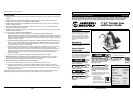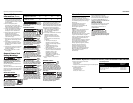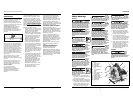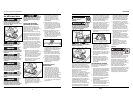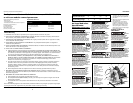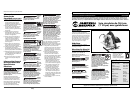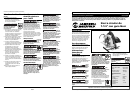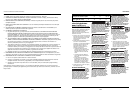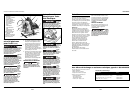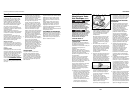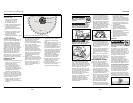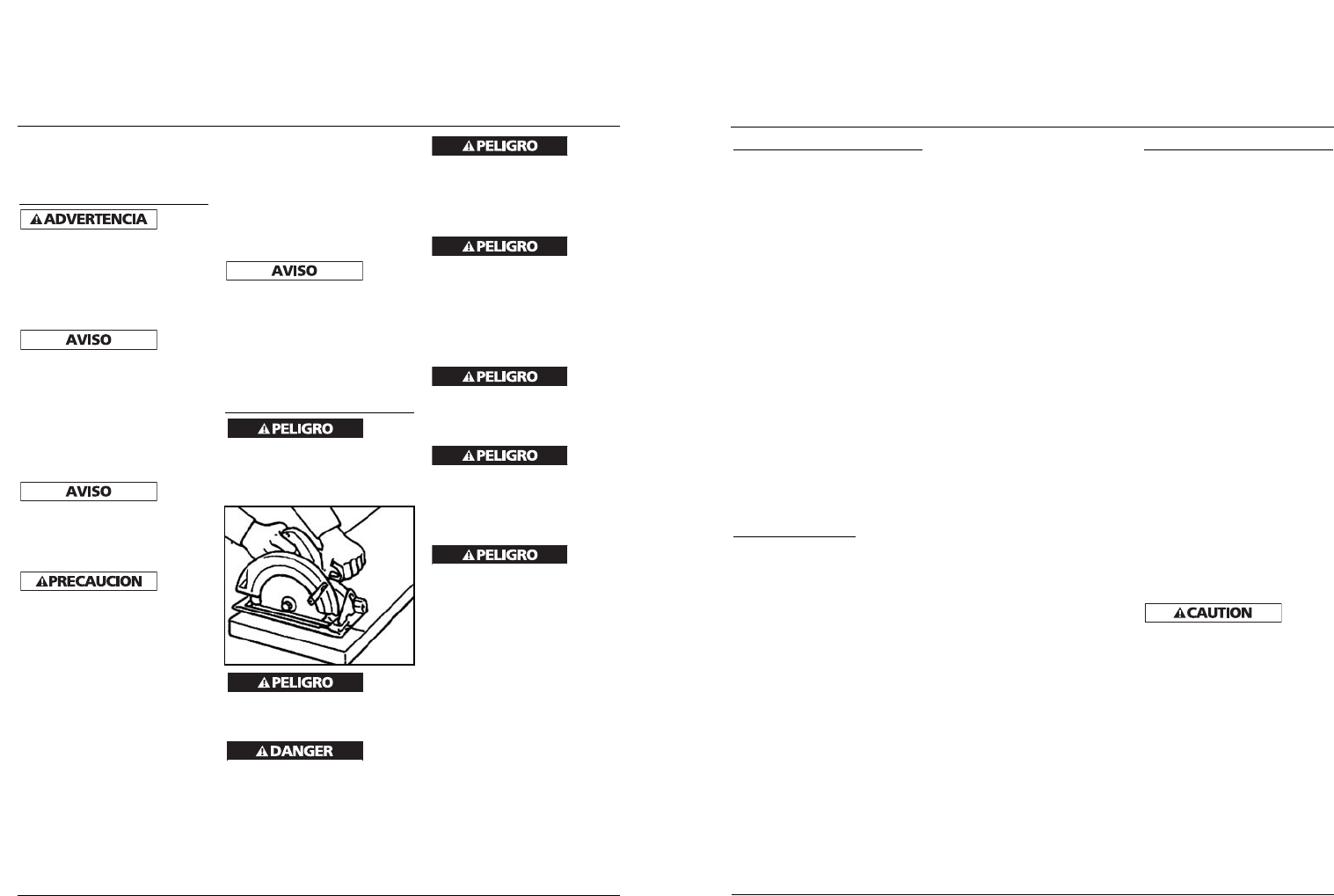
Información General
de Seguridad sobre
Herramientas
Eléctricas (Continuación)
Almacene
las
herramientas eléctricas desactivadas
fuera del alcance de niños y no permita
que personas que no estén
familiarizadas con herramientas
eléctricas o con estas instrucciones,
hagan funcionar una herramienta
eléctrica. Las herramientas eléctricas
son peligrosas cuando están en manos
de usuarios inexpertos.
Preste
mantenimiento a las herramientas
eléctricas. Verifique que las piezas
móviles no estén desaliñadas ni
bloqueadas, que no haya piezas rotas
yque no exista ningún otro problema
que pueda afectar el funcionamiento
de la herramienta. Si está dañada, haga
reparar la herramienta eléctrica antes
de usarla. Muchos accidentes son
causados por herramientas eléctricas
que no tienen un mantenimiento
adecuado.
Mantenga
sus
herramientas de corte afiladas y
limpias. Es menos probable que las
herramientas de corte con un
mantenimiento adecuado y con bordes
de corte afilados se atasquen y además
son más fáciles de controlar.
Use la
herramienta eléctrica, sus accesorios
yUse la brocas etc. de acuerdo con
estas instrucciones, tomando en cuenta
las condiciones de trabajo y el trabajo
que desea hacer. El uso de una
herramienta eléctrica para trabajos
diferentes de aquellos para los cuales
ha sido diseñada, puede resultar en
una situación peligrosa.
1. NO use ninguna rueda abrasiva.
2. Esta herramienta NO debe
modificarse ni usarse para cualquier
aplicación que no sea la aplicación
para la cual fue diseñada.
3. Use solamente accesorios
recomendados por el fabricante de
su modelo. Los accesorios
apropiados para una herramienta
pueden causar un riesgo de lesión
cuando se usan con otra
herramienta.
4. Algunas maderas contienen
conservadores que pueden ser
tóxicos. Tenga especial cuidado
para evitar la inhalación y el
contacto con la piel con estos
materiales. Solicite y cumpla con
toda la información de seguridad
disponible por parte de su
proveedor de materiales.
MANTENIMIENTO
Haga que sólo personal calificado
preste mantenimiento a su herramienta
eléctrica y usando sólo repuestos
idénticos. Esto asegura que se preserva
la seguridad de la herramienta
eléctrica.
Instrucciones de
Seguridad para Todas
las Sierras Eléctricas
Mantenga las manos alejadas del área
de corte y de la hoja. Mantenga su otra
mano sobre la palanca auxiliar o caja
del motor. Si está sosteniendo la sierra
con ambas manos, no correrá riesgo de
cortárselas con la hoja.
No
intente
alcanzar nada debajo de la pieza de
trabajo. Debajo de la pieza de trabajo
la protección no puede protegerlo de la
hoja.
Ajuste
la
profundidad del corte según el grueso
de la pieza de trabajo. Menos de un
diente completo de la hoja debe ser
visible debajo de la pieza de trabajo.
Nunca
sostenga
una pieza que está cortando en sus
manos ni sobre sus piernas. Sujete la
pieza de trabajo a una plataforma
firme. Es importante apoyar el trabajo
correctamente para minimizar la
exposición corporal, el atascamiento de
la hoja o la pérdida de control.
Cuando
esté
efectuando un trabajo por el cual la
herramienta de corte puede entrar en
contacto con un cable eléctrico oculto o
su propio cable, sujete la herramienta
eléctrica por las superficies de sujeción
aisladas. Al entrar en contacto con un
cable “bajo tensión” las piezas
metálicas de la herramienta conducirán
la electricidad y el usuario recibirá un
choque eléctrico.
Para un
corte
recto use siempre una guía de corte o
una guía con borde derecho. Esto
mejora la precisión del corte y reduce
la posibilidad de atascamiento de la
hoja.
Siempre
utilice
hojas con orificios del mandril del
tamaño y forma correctos (en diamante
contra redondos). Las hojas que no
coincidan con la ferretería de montaje
de la sierra funcionarán de forma
excéntrica, causando la pérdida de
control.
No use
nunca
arandelas o pernos para la hoja que
estén dañados o sean inapropiados. Las
arandelas y pernos de la hoja han sido
especialmente diseñados para su sierra,
para proporcionar el mejor
rendimiento y un funcionamiento sin
peligros.
22 Sp
Manual de Instrucciones y Lista de Piezas
7
DG411200CK
Operation (Cont’d.)
Ripping
Ripping is cutting length-wise with the
grain. Select the proper blade for your
job. Use a edge guide for rips 4" wide
or less. To install the edge guide, slide
the bar through the edge guide slot in
either side of the base. The width of
the cut is the distance from the inside
of the blade to the inside edge of the
edge guide.
Adjust the edge guide for the desired
width, and lock the setting by
tightening the edge guide securing
knob.
When ripping widths greater than 4",
clamp or tack 1" lumber to workpiece
and use the inside edge of the
baseplate as a guide.
Cross-Cutting
Cross-cutting is cutting across the
grain. Select the proper blade for your
job. Advance the saw slowly to avoid
splintering the wood.
Pocket Cutting
Pocket cuts are made in the middle of
the workpiece when it cannot be cut
from an edge. We recommend using a
reciprocating saw or jig saw for this
type of cut. However, if you must use a
circular saw to make a pocket cut,
USE
EXTREME CAUTION.
To maintain control of the saw during
pocket cutting, keep both hands on
the saw.
1. Beginning at a corner, line up the
saw’s sight line with your cutting
line. Tilt the saw forward, firmly
fixing the front of the base plate
on the workpiece. The blade should
be just above cutting line,but not
touching it. Raise the lower guard
using the guard lever.
2. To start the saw, push the lock-off
button in while pulling the trigger.
Allow the motor to reach full speed
before beginning cut. Using the
front of the base plate as a hinge
point, gradually lower the back end
of the saw into the workpiece.
Release the guard lever and grasp
the front handle.
3. When the base plate rests flat
against workpiece, advance the saw
to the far corner. Release the
trigger and allow the blade to
come to a complete stop before
removing it from workpiece.
Repeat the above steps for each
side of the opening. Use a
reciprocating saw, jig saw or small
hand saw to finish the corners if
they are not completely cut
through.
EDGE GUIDE
The edge guide allows you to do
accurate straight cuts. Simply slide the
guide up snugly against the side of the
work piece and secure it in position
with the clamp screw on the front of
the base. The edge guide can also be
used to make repeated cuts of uniform
size.
BEVEL ADJUSTMENT
Always be sure that the tool is switched
off. Unplug the tool. The base can be
adjusted up to 45° by loosening the
bevel adjustment knob at the front of
the saw.
Align to desired angle on calibrated
quadrant. Then tighten bevel
adjustment knob. Because of the
increased amount of blade
engagement in the work and
decreased stability of the base, blade
binding may occur.
Keep the saw steady and the base
firmly on the workpiece.
DEPTH ADJUSTMENT
Always be sure that the tool is switched
off. Unplug the tool. Loosen the lever
on the depth guide and move the base
up or down. At the desired depth of
cut, secure the base by tightening the
lever.
Maintenance
Tool service must be performed only
by qualified repair personnel. Service
or maintenance performed by
unqualified personnel could result in
a risk of injury.
If the tool does not work properly,
return the tool to a service facility for
repairs.
Cleaning
Clean out dust and debris from vents
and electrical contacts by blowing with
compressed air. Keep tool handles
clean, dry and free of oil or grease.
Use only mild soap and a damp cloth
to clean the tool, keeping away from
all electrical contacts.
Certain cleaning agents and solvents
are harmful to plastics and other
insulated parts. Some of these include
gasoline, turpentine, lacquer thinner,
paint thinner, chlorinated cleaning
solvents, ammonia and household
detergents containing ammonia.
Never use flammable or combustible
solvents around tools.
LUBRICATION
For your continued safety and
electrical protection, lubrication and
service on this tool should ONLY be
performed by an AUTHORIZED
CAMPBELL HAUSFELD SERVICE
CENTER.
TECHNICAL SERVICE
For information regarding the
operation or repair of this product,
please call 1-800-424-8936.
Tool
service
must be performed only by qualified
repair personnel. Service or mainte-
nance performed by unqualified per-
sonnel could result in a risk of injury.



